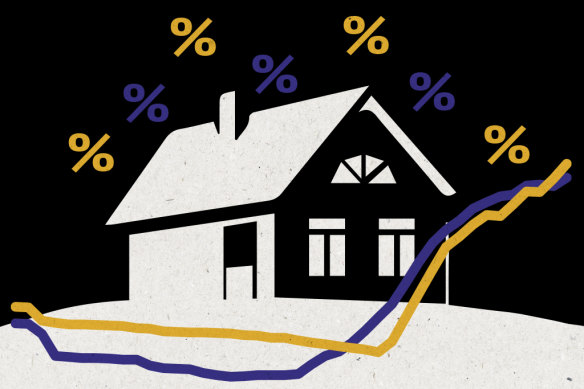This was published 1 year ago
Borrowers warned to prepare for Melbourne Cup rate rise
By John Collett
Borrowers are being warned to prepare their budgets for an interest rate “peak” of 4.35 per cent after higher inflation figures and retail sales data for September have seen odds of a Melbourne Cup Day rate rise shorten.
Reserve Bank governor Michele Bullock said last week that price pressures had been a “little higher” than had been expected, but were not a surprise. The bank was still assessing what inflation and other data would mean for its forecasts for the economy.

Those struggling with their home loan repayments should talk to their lender.Credit: Marija Ercegovac
However, economists at all four of the big four banks expect a 0.25 percentage rate rise on Tuesday, to take the cash rate to 4.35 per cent; though they say a rate increase is not certain.
“While 4.35 per cent should mark the peak in the cash rate, there is a risk it could tighten beyond that. Any [lowering of the cash rate] remains a very long way off,” the ANZ economists say.
Commonwealth Bank economists say the solid pace of retail sales growth in September – higher than market estimates – adds to the case for a resumption of the rate raising cycle on November 7, a thesis also supported ANZ economists.
Retail sales rose 0.9 per cent in September and were up 2 per cent over the last 12 months.
An increase in the cash rate of 0.25 percentage points to 4.35 per cent on Tuesday would add $76 a month to the repayments on a $500,000 mortgage with 25 years to run.
That would add $1210 to the monthly repayments on a $500,000 mortgage since the cash rate first rose in May last year – a cumulative increase of 52 per cent, figures from RateCity show.
Someone with a $750,000 mortgage with 25 years to run would have seen a total increase in payments of $1815 since rates started their upward trajectory.
“Borrowers need to start getting their head around what a 13th rate hike would look like in their budget because, at this point, the data is starting to point in this direction,” says Sally Tindall, the research director at RateCity.
“A rate hike in November is by no means a done deal, but borrowers should start preparing, nevertheless. Call up your bank today and ask them for a rate cut. The banks are still in the mood to negotiate, especially if they think you’re a flight risk [to another lender],” Tindall says.
Mozo spokesperson Rachel Wastell says another rise rate would place even more pressure on borrowers, many of whom are just trying to keep their heads above water as they struggle with the exorbitant cost of everyday items like fuel and groceries.
“Recent Mozo research showed one in six Aussies are already spending 40 to 60 per cent of their monthly household income on their home loan repayments, so a 13th rate hike is likely to cause some pain,” she says.
“On the Mozo database, the variable rates from the big four are currently averaging around 7 per cent, whereas we’re seeing smaller lenders offering variable rates starting with five,” Wastell says.
A new advertising campaign, overseen by the Australian Banking Association, is urging people not to do it tough on their own.
The association’s chief executive officer, Anna Bligh, said there were reassuring signs that many customers are navigating the unpredictable economic climate well, but noted it was important to look out for the warning signs of financial stress.
Bligh said that the earlier people reached out, the faster banks could help by lowering home loan or credit card loan payments, restructuring the length of a loan, temporarily moving them to interest-only payments or deferring payments for a period.
“The spiral into financial hardship can happen very quickly, but early assistance can make a real difference – please talk to your bank,” she said.
- Advice given in this article is general in nature and is not intended to influence readers’ decisions about investing or financial products. They should always seek their own professional advice that takes into account their own personal circumstances before making any financial decisions.
Expert tips on how to save, invest and make the most of your money delivered to your inbox every Sunday. Sign up for our Real Money newsletter.